It was about 10.30 in the morning and vehicles were depositing tourists outside Bikaner’s Junagarh Fort. As I walked up to the Fort’s entrance, I overheard these comments:
“This is a fort? Isn’t a fort supposed to be, like, on a hill?”
“This is no fort. It looks more like a walled palace.”
“And why is it called Junagarh Fort? Junagadh is in Gujarat. Shouldn’t this be called Bikaner Fort or something?”
“Are you sure we are at the right place? Is this the only fort in Bikaner?
Now, if I had also been deposited outside the Fort in question like these people and was seeing the Fort for the first time, it is quite possible that I might have asked some of the questions myself. But since I had the opportunity to see the Fort from my hotel terrace the previous evening (see photo below), I knew that though it was not on a hill, it was a proper fort alright with a moat and all other fortifications befitting one.

I could also see Bikaner’s flat landscape from the terrace, which indicated that the builders of the fort had no choice in the terrain. And, yes, I could also see that this was the only fort around. The only answer that the view of the Junagarh Fort from the hotel terrace did not give was why it was called so.
I hoped that a tour of the Fort complex would answer questions for all of us.
Bikaner was founded by Rao Bika, the second son of Rao Jodha (the founder of Jodhpur) in 1488. It is said that Bika did not have very good relations with his father and brothers and in exchange for giving up his claim to the throne of Jodhpur, was allowed to take the heirlooms of the Rathore dynasty with him when he left Jodhpur forever. However, rivalry between the two kingdoms lasted till the 19th century. Sometimes, this rivalry even escalated into open warfare.
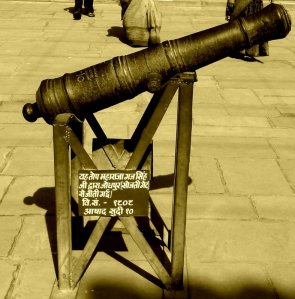
In one of the courtyards inside the palace in the Fort is a cannon captured by Maharaja Gaj Singh, the 14th ruler of Bikaner, in 1808. As cannons go, this one is a baby cannon. But the pride of place it has got for display indicates that capturing this cannon must have been a matter of great prestige for Bikaner.
The Junagarh Fort is not the first fort built in Bikaner; Rao Bika had built a stone fort when he founded this city. But today, only scattered fragments of Rao Bika’s original fort survives.
Unlike most forts in Rajasthan and elsewhere in India, the Junagarh Fort of Bikaner is a land fort. It’s foundations were laid in 1589 by Maharaja Rai Singhji, the 6th ruler of Bikaner. Known as Chintamani Durg, construction of the Fort was completed in 1593 and 20 kings have resided in the Fort since then till 1902 when the royal family moved out into Lalgarh Palace. And that’s when the name Junagarh Fort came about. The Fort was “donated” to the Maharaja Rai Singhji Trust in 1968 by the 23rd ruler of Bikaner, Maharaja Karni Singhji. Since then, the Junagarh Fort has been open to the public.
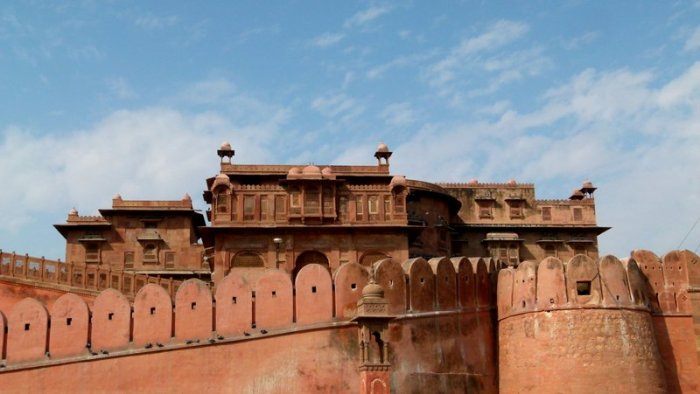
 The Junagarh Fort is built from red sandstone and with its cluster of low-rise buildings within has never been conquered, in spite of many battles fought in the area. And you realise why only when you enter the Fort. A land fort it may be, but the Junagarh Fort has all possible defense mechanisms in place. There is a deep, but currently dry, moat surrounding the fort walls. Then there are a series of gates that one has to pass through (each one accessed after twists and turns).
The Junagarh Fort is built from red sandstone and with its cluster of low-rise buildings within has never been conquered, in spite of many battles fought in the area. And you realise why only when you enter the Fort. A land fort it may be, but the Junagarh Fort has all possible defense mechanisms in place. There is a deep, but currently dry, moat surrounding the fort walls. Then there are a series of gates that one has to pass through (each one accessed after twists and turns).
The gates are fitted with wicked looking nails at “elephant height”, that is at the height of an elephant’s head. Since elephants were used to batter down the defensive gates in forts, the nails acted as a deterrent for elephants to ram their heads on the gates.
After passing through all the gates, one enters the ceremonial courtyard to get that first breathtaking glimpse of the palace façade, which hints at the architectural treasures within. The lower levels are built of red sandstone and the upper levels from yellow sandstone. As I was to find out later, this uniform architectural style on the exterior hides a series of buildings that were built at different times by different rulers and with different architectural elements.
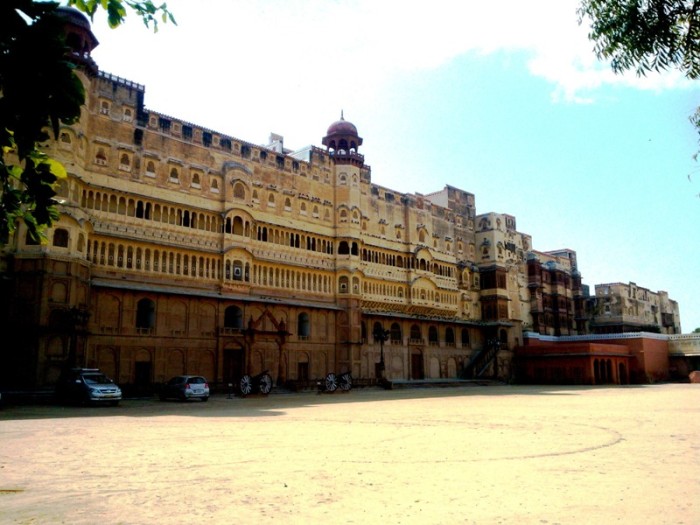
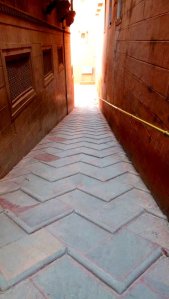 The palace complex is accessed through a narrow, steep ramp (see photo on left) which leads into the first of the many courtyards around which the rooms in the palace are arranged. Each courtyard is different — if one courtyard is built entirely of red sandstone, another is built with sandstone and some marble, a third is almost entirely made of marble with coloured tiling, another with painted frescoes, and yet another with inlay work.
The palace complex is accessed through a narrow, steep ramp (see photo on left) which leads into the first of the many courtyards around which the rooms in the palace are arranged. Each courtyard is different — if one courtyard is built entirely of red sandstone, another is built with sandstone and some marble, a third is almost entirely made of marble with coloured tiling, another with painted frescoes, and yet another with inlay work.
The rooms leading off from the courtyards are also vastly different. If the Karan Mahal or the public audience hall was built with Mughal architectural influences, there was Anoop Mahal or the Privy Council Room which has some dazzling gold inlay work interspersed with some real gems like emeralds and rubies. Then there was the delicate Phool Mahal, the oldest part of the palace complex, with motifs of flowers as stucco work and glass inlay work, and the grand and cavernous Durbar Hall with the ceremonial 1,100-year-old sandalwood throne.
But the ‘mahal’ that literally took my breath away was Badal Mahal or the palace of clouds. The longing for rain in an arid area like Bikaner has been captured on every inch of the walls in the Badal Mahal with blue clouds interspersed with lightning motifs painted on its walls and ceilings. As looked around me, I swear, I could hear Raga Megh Malhar in the background.


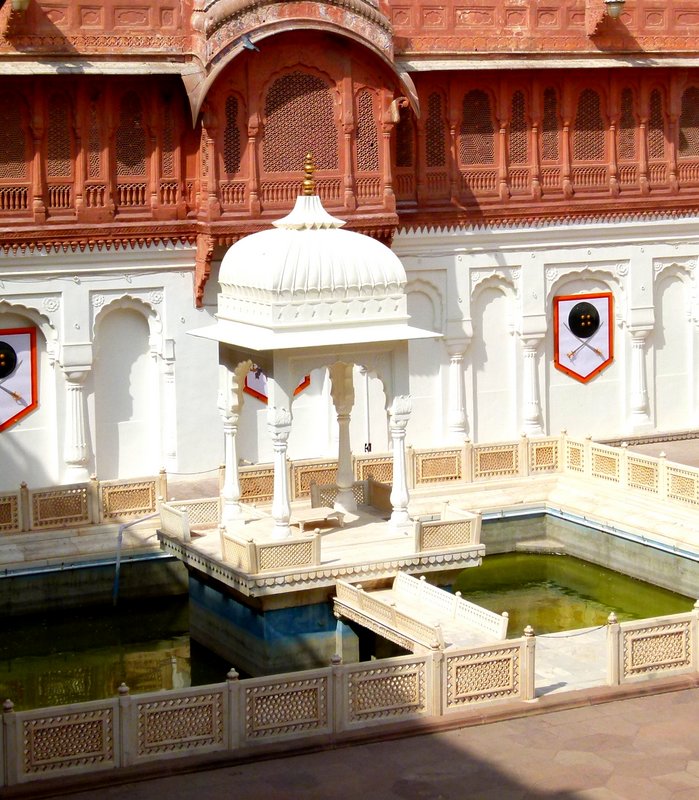


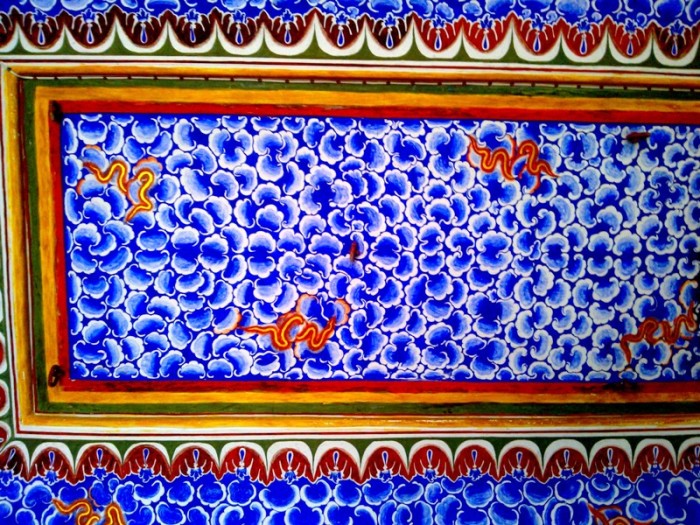

The palace complex is full of dazzling objects like a silver throne, a sandalwood throne, a golden swing, palanquins and howdahs used by the royal family, and even a Haviland Plane, among hundreds of other objects. This plane, which is displayed in the Vikram Niwas Durbar Hall, was pieced together from the parts of two shot down DH-9DE Haviland Planes.


The Junagarh Fort also houses Pracheena, a museum that displays contemporary arts and crafts, ritual crafts, period furniture, textiles and costumes used by the royal family, royal photographs and miniatures, among many others. This museum is a veritable treat for the eyes and gives a glimpse into the everyday life of the royals. There are framed menus on display as are the delicate crockery and cutlery. Two display items caught my eye.

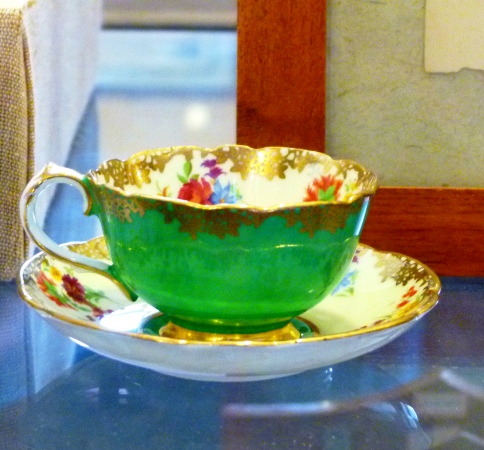
Only a small portion of the Junagarh Fort is open to the public and I took about 2-3 hours to cover it thoroughly. As I walked out, I noticed something that I had missed seeing while coming in: handprints of royal women who had committed sati. It was a sobering sight and somehow I am glad I saw it on my way out rather than on my way in.
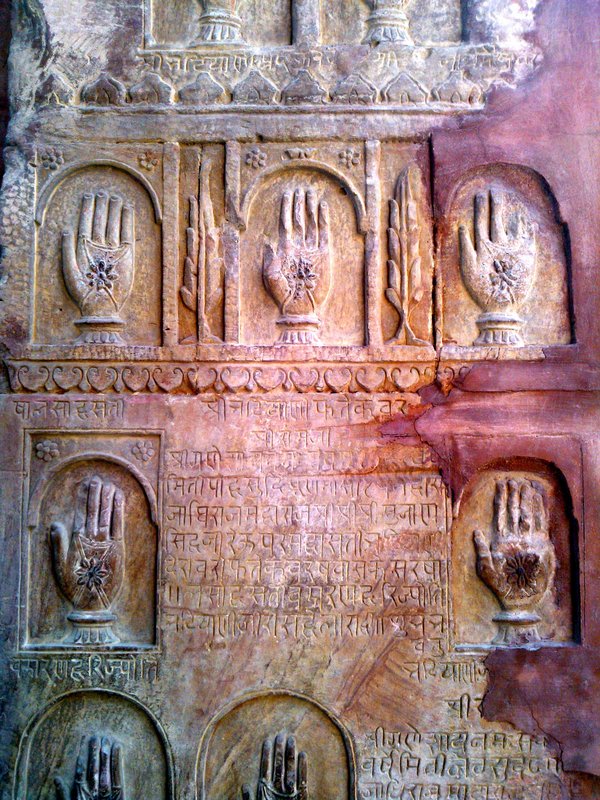
 There were quite a few people visiting the Fort that day and between them, their guides and some typical Indian jostling and shoving, it was difficult to keep track of where I was and sometimes even what I was seeing.
There were quite a few people visiting the Fort that day and between them, their guides and some typical Indian jostling and shoving, it was difficult to keep track of where I was and sometimes even what I was seeing.
In hindsight, I really regret not hiring an audio guide for the tour of the Junagarh Fort (something which I did for my tour of the Mehrangarh Fort in Jodhpur). Not only would I have taken a more orderly tour of the Fort, I would also have managed to shut out the din of the other tourists around. Though the mind and camera recorded what I saw, sometimes the details either didn’t register immediately or got mixed up. The grandness of the palace complex only ensured that I walked around in a daze with my mouth open most of the times.
This brings me to the point as to why more people do not visit Bikaner. A casual search on the Internet on Rajasthan reveals that Bikaner is not really talked about as much as other places; Jaipur, Jaisalmer, and Jodhpur overshadow it. This is a real shame as Bikaner has much to offer in terms of history, architecture, food, heritage and the arid desert. And after having visited these popular cities, I can say that Bikaner’s history is as unique and different as theirs. And one that must be experienced.
And you will visit Bikaner, won’t you? 🙂
======================
Forts of Rajasthan Series

Yes I will 🙂 Your blog is enticement enough 🙂
LikeLike
Thank you, Thandapani. I’m sure you will not be disappointed 🙂
LikeLike
no doubt… 🙂
LikeLike
Your blog is one of the few I will look up your blog before planning a trip to Rajasthan! Loved the post – pics and details both.
LikeLike
Thank you very much, Chattywren. I hope you get to visit Rajasthan soon 🙂
LikeLike
I loved the Anop Mahal, the sheer richness of the stonework in the picture takes my breath away. I have half a mind to throw a world class tantrum so DH and the office let me take off to India and Rajasthan on the next flight
LikeLike
In spite of the dim lighting, Anup Mahal still dazzled. But the Badal Mahal glowed, much like it does in the picture. Plpease, please throw that tantrum and come to India. I was hoping to meet you this March, and am quite tempted to throw a tantrum myself 😦
LikeLike
Excellent post on Junagarh fort. Nice photos.
http://rajniranjandas.blogspot.in/2013/03/the-mughal-wonders-of-lucknow.html
LikeLike
Thank you very much, Niranjan.
LikeLike
I will definitely visit Bikaner whenever I visit Rajasthan. It is a long-pending dream trip for both of us. 🙂
Have heard a lot about Bikaneri cuisine. Did you get to experience any delicacies?
Stunning pics, especially the one of the blue clouds in Badal Mahal. Interesting history behind the fort, too. I wish history in schools was taught this way! 🙂 And, you got all of this information without hiring a guide? :O Where are thy feet?
LikeLike
Yes, I got to sample Bikaneri cuisine and quite liked it, even though it was spicy for my taste. I particularly like safed aloo, a potato preparation in a white gravy.
I wish history was taught differently in school too, TGND. I always enjoyed history in school, but visiting Rajasthan was so much more and left me imagining “what if this particular lesson had been taught this way?”
There are information boards all around and there were enough guides around to eavesdrop and listen to. That’s where I got my information for this post. 🙂
LikeLike
What a beautiful way to start a boring afternoon of work. Wonderfully written Sudha! The pictures as usual are stunning. The red and yellow sandstone facade of the Fort is impressive. The blue and red frescos are so beautifully detailed. The tea cup is amazing….I would love to drink tea from a cup like that.
The hand prints is a cold reminder to all of us that beauty comes with a price. Somehow, our history books gloss over the gory details of sati.
LikeLike
I put in the tea cup just for you as I knew you would definitely comment on it. 🙂
Junagarh Fort came as a complete surprise as it is not spoken or written about too much. So, I guess my post brings out that element of wonder as well.
Regarding sati, this panel blends in with the stone of the fort walls and is easily missed. Also in Bikaner nobody talks about sati openly, unlike in Jaisalmer, Jodhpur and Chittorgarh. But this panel did give me a shock – reading about sati in a history book is very different that actually seeing evidence of something like this having happened.
LikeLike
Lovely place would like to go there once. Thanks for sharing .
Travel India
LikeLike
And you should visit Bikaner for a very different side of Rajasthan that is not spoken about or discussed in tourist circles. Glad you liked, Vishal.
LikeLike
After this write-up who would not want to visit Bikaner, Sudha? 🙂
LikeLike
I don’t know, Suresh. You haven’t said that you will visit Bikaner, have you 😉
LikeLike
I’ll be honest. I was more enticed by the pictures, not to say that I didn’t enjoy the write up but the pictures drew me in! 🙂 Beautiful post Sudha, makes me want to hop over to Rajasthan right away!
LikeLike
Psst… I’ll be honest too. This was one post where I chose the photos first and then wrote a narrative around it. And you must, must plan a trip to Rajasthan. 🙂
LikeLike
This is a beautiful fort and palace.
LikeLike
Yes, it is Rajesh. And since I had not seen any pictures or read any write-up about the Fort and Palace, it made the visit all the more beautiful 🙂
LikeLike
Wow ! What an impressive fort. Though at disadvantage for being on a flat land, its surprising how it never got conquered. Great photographs ! 🙂
Forts and Havelis apart, when are you giving us a guided tour into the streets of Bikaner ? 🙂
LikeLike
Thanks, Purnendu. When I asked around about the reasons for the Fort not being captured, I didn’t really get satisfactory answers. But the little history that I got to read at the museums shows that the Bikaner rulers entered into a lot of strategic alliances with the Mughals and the British. Maybe they always had additional support during battles… And the Junagarh Fort may be a landfort, but its defences are on par with the other forts I saw in Rajasthan.
As for a guided tour of Bikaner, that is not going to happen this time. You see, um… er… *with an embarrassed look* I forgot my camera AND cellphone when I went for a walk of the city. 😦
LikeLike
Looks marvelous and elegant and off course enigmatic…the baithak looks haunting.
LikeLike
Welcome here, Numerounity, and thank you so much for stopping by and commenting. As I have mentioned in my replies to earlier comments, part of the delight in visiting the Junagarh Fort was in never having seen or read anything about it. Add to this typical Rajasthani grandeur and this made for an unforgettable experience.
LikeLike
Lovely post once again. Beautiful pictures too. Rajasthan is full of so much history it’s simply unbelievable. Great lesson 🙂
LikeLike
Thank you, Raghav 🙂 I felt like I was looking through the pages of a history book myself all the time.
LikeLike
Excellent pics. Especially the later ones. I am so jealous of u!! Rajasthan has been on my bucket list for long..
LikeLike
Thank you, NS. Rajasthan is indeed beautiful and one that lends itself beautifully to the “Incredible India” slogan very aptly. Plan a holiday to Rajasthan the next time you’re in India 🙂
LikeLike
Lovely pics. And oh for a cup of tea in that beautiful green cup!!
I have only been to Jaipur in Rajasthan, and plan to take an extended trip to cover the rest of Rajasthan some day–will surely visit Bikaner too.
LikeLike
I all the great forts in India were build in Rajasthan. very few are on other part of India. Even if build kings were from Rajasthan LIke in Gwalior.
LikeLike
I wouldn’t agree with you on this statement. The forts in Rajasthan are well known and perhaps well maintained. Have you seen the forts in other states like Maharashtra, Tamil Nadu, Karnataka and Kerala. None of these were built by kings from Rajasthan.
LikeLike
Really beautiful pictures….
LikeLike
Thank you very much 🙂
LikeLike
Thank you for this blog with amazing photos of Junagarh fort. Bikaner is a vibrant, dust-swirling desert town with fabulous forts. It’s less dominated by tourism than many other Rajasthan cities, though there are many places to visit in Bikaner full of amazing flora and fauna to explore.
LikeLike
Thank you Debosmita. Glad you enjoyed reading it. I like Bikaner a lot for its unique architecture and interesting places to visit.
LikeLike